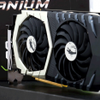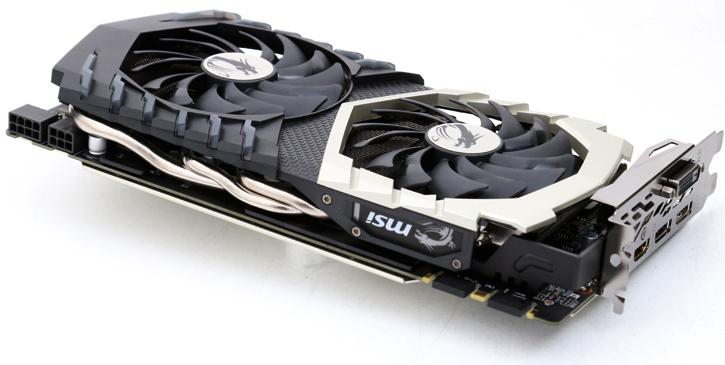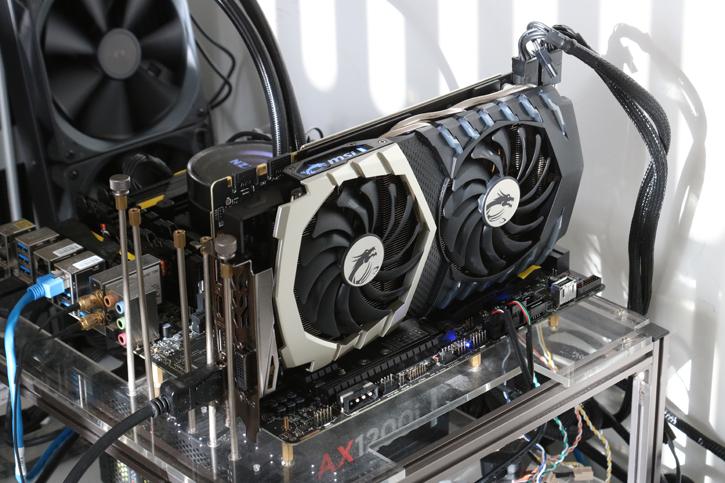Conclusion
Conclusion
MSI offers the Titanium series with TwiNFrozr cooler and yeah, aside from colors and the one additional heat pipe in the cooler, these products are the same really. As always the design works really good. The Nvidia GP104 yield is pretty incredible after a year so the reality is that the chips are rather efficiently and overclockable. Also, we're surprised to see the 1070 Ti is even more silent. Overall then, when AMD launched Radeon RX Vega 56 and 64, the one product where Nvidia did not really have a direct answer for was that Vega 56. That's why they figured, hmm it's almost Christmas season, let's make sure we have that product covered. And so a new baby Ti was born. To do so the took the GP104, reconfigured it a bit and then realized they needed to slow it down as it quite easily can match the GTX 1080. This is mainly the reason why you will see the AIB partners all offering their 1070 Ti cards at the same clock frequencies, as a faster product would cannibalize the GTX 1080. Guess what? Grab the latest beta of our homegrown MSI AfterBurner (we already updated it for the 1070 Ti) and tweak the fracker until that smile on your face is bigger then the length of a GTX 1080 Founder Edition :) Really, things are that simple as all board partners will offer product with more cooling then is good for the 1070 Ti. In the case of the MSI Gaming, where the card shines, however, is its cooling performance, this card is running 65~66 Degrees C under full load. Apply a tweak as suggested, and have this new card bring in a nice gain up-to (let's say) 10% in performance. And that certainly is interesting. As always, the performance on all models including tweaking results is all more or less the same due to the restrictions Nvidia applies. If the cooler is good enough, throttling will not occur. Hence differentiation in design, noise levels, and cooling is key and king to the board partners. The looks are very as usual and the card has a limited thus okay LED implementation and then there are the extra features like the number of display connectors. Let me reiterate that due to all Nvidia limitations the differences in performance in-between all 1070 Ti models is negligible to NIL in a 1 or 2 FPS margin. The problem with the highest-end SKUs is that they are more expensive, and that extra money just does not justify the little performance gain. The problem for the 1070 Ti, however, is that it is going to sit in a saturated segment, people that wanted Pascal already will have purchased a 1070 or 1080 in my belief. So for this product to make real sense, it needs a sharp and edgy low price. We feel it's a 400 Euro/USD card really, however, expect prices being close to the 475~500 USD marker, which would be unfortunate.
Aesthetics
MSI kept things the same with the stylish but dating (in looks) TwinFrozr VI cooler, now in the silver/metal/black design. The top logo etc you can switch on/off or to any color and animation you prefer, the choice is yours. Cool dibs is that backplate, with an opening at the proper areas (GPU/VRM) for venting. As you can see, I remain skeptical about backplates, they potentially can trap heat and thus warm up the PCB. But the flip-side is that they do look better and can protect your PCB and components from damage. Consumer demand is always decisive, and you guys clearly like graphics cards with backplates. Both the front IO plate and backplate are dark matte black which certainly gives the card that premium feel. All that combined with a nice design 10 phase PCB again in matte black, and the end result is a lovely looking product.
Cooling & Noise Levels
For GeForce GTX 1070 Ti anything below 80 degrees C is good as that is the threshold marker (above it) where it would start to throttle down in clock frequencies to meet a maximum temperature target. That's throttling and is part of the design.
MSI, however, throws in a cooler that manages roughly massive cooling performance. TwinFrozer revision 6 with the extra heatpipe and new Torx fans really are good, so good that up-to a degree or 60 on the GPU, this card remains passive and thus inaudible. Once the fans kick in, you can expect to hover at the 65~66 Degrees C marker, with seriously GPU intensive games. Please do note that you will need proper ventilation inside your chassis to achieve that number. So MSI shaved off a good 15 Degrees C over reference. Noise wise, we can’t complain about cooling whatsoever. Expect sound pressure values in the 34~35 dBA range at max under load and warm circumstances. This means you can barely hear the card while using it if you could hear it at all. Once overclocked with added voltage we always do recommend a little more fan RPM, this does increase noise a tiny bit, but it's nothing dramatic by any standard. Overall this is a very sound and solid cooling solution.
Power Consumption
Any GP104 Pascal GPU and thus GP104 based graphics card is rated as having a 180 Watt TDP under full stress, our measurements show it to be in the 170 Watt range. At this level you are looking at a card that consumes roughly 400~450 Watts for a stressed PC (in total), that is okay. We think a 500~600 Watt PSU would be very sufficient and, if you go with 2-way SLI, a 750 Watt power supply is recommended. It's definitely more than needed but remember - when purchasing a PSU, aim to double up in Wattage as your PSU is most efficient when it is under 50% load. Here, again, keep in mind we measure peak power consumption, the average power consumption is a good notch lower depending on GPU utilization. Also, if you plan to overclock the CPU/memory and/or GPU with added voltage, please do purchase a power supply with enough reserve. People often underestimate it, but if you tweak all three aforementioned variables, you can easily add 200 Watts to your peak power consumption budget as increasing voltages and clocks increase your power consumption.
Overall Gaming Performance
If you game at a resolution of 1920x1080 (Full HD) up-to 2560x1440 (WQHD) then the 1070 Ti series is going to be very sufficient. The card does sit in a nice high-end (but not enthusiast) range that will suit many of you just fine. If you stick to the aforementioned resolutions then there's not one game that won't run really good combined with the best image quality settings. Gaming you must do with a nice 24" monitor of course, at 2560x1440/1600 would actually be a perfect fit. The 8 Gb graphics memory is excellent, making the product more future proof. Starting with Pascal the primary focus for Nvidia in terms of multi-GPU setups is that they will support 2-way SLI, but really that's it and all.
Overclocking
Due to the many limiters and hardware protections, Nvidia has built in, all and any cards will hover roughly at or just over the 2.0 GHz level on the Boost marker. Now, the one factor that can actually positively influence the boost speed a little is temperature as the GPU will then throttle less. And that did show as we could boost to 2,050~2,100 MHz, that is stable. On 3DMark Firestrike with this card tweaked (for example) it may hover at ~2,075 MHz, while in Rise of the Tomb Raider (2016) you will be closer to 2.1 GHz. The reality is that Nvidia monitors and adapts to hardware specific loads, e.g. an application that is nearly viral like on the GPU will have the effect of the GPU protecting itself by lowering clocks and voltages. The opposite applies here as well, if a game does not try to fry that GPU, it'll clock a bit faster within the tweaked thresholds at your disposal.
Concluding
The titanium is all about the looks, something different in the MSI Gaming series bracket. They offer different looks, a cooler with one more heatpipe but other than that, this is the same stuff as the Gaming model offers with the typical performance offset and normal baseline performance. Nvidia did what it needed to do, create an answer towards the Vega 56, really that's all that this product is about aside to create a new SKU for the Holiday season. The problem, however, is that most people already will have bought a 1070 or 1080, and is seen from that perspective I doubt that the Ti would be appealing for them. Also, the ones that will need a graphics upgrade probably will go with the cheaper SKU, the GTX 1070. The ones that can spend more money probably will sit it out and wait on Volta. In that mindset, I find the Ti a bit of a weird release that fills a gap just to match the Vega 56. So compared to that Vega 56 or GTX 1070 the 1070 Ti is merely a small step up in additional performance and that alone is not enough to justify an upgrade if you are already fragging away in that Vega56/Vega64/1070/1080 performance bracket. The GTX 1070 Ti series is however lovely for up-to 2560x1440 gaming. In relative performance, the Ti offers good performance and you will gain from a nice manual overclock, but so will that regular 1070, of course. MSI once again offer a really good product here with a slightly different twist on the cooler in style and well, that one extra heatpipe. But hey, it's again really silent, cools great and offers performance and tweaking levels on the GPU that are really good. The memory was a bit less tweakable though, but that's really the only thing I can nitpick about. If you are in the market for a 1070 Ti, recommended.
Recommended Downloads
- Sign up to receive a notice when we publish a new article
- Or go back to Guru3D's front page




